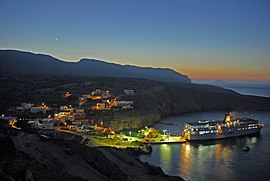Anticythera
|
Antikythera Αντικύθηρα |
|
|---|---|

Antikythera's harbour Potamos
|
|
| Coordinates: 35°52′N 23°18′E / 35.867°N 23.300°ECoordinates: 35°52′N 23°18′E / 35.867°N 23.300°E | |
| Country | Greece |
| Administrative region | Attica |
| Regional unit | Islands |
| Municipality | Kythira |
| • Municipal unit | 20.43 km2 (7.89 sq mi) |
| Population (2011) | |
| • Municipal unit | 68 |
| • Municipal unit density | 3.3/km2 (8.6/sq mi) |
| Time zone | EET (UTC+2) |
| • Summer (DST) | EEST (UTC+3) |
| Postal code | 801 00 |
| Area code(s) | 27360 |
| Vehicle registration | Z |
| Website | www.antikythira.gr |
Antikythera or Anticythera (/ˌæntɪkɪˈθɪərə/, /ˌæntɪsɪˈθɪərə/; Ancient Greek: Ἀντικύθηρα Greek: Αντικύθηρα, [andiˈciθira], literally "opposite Kythera") is a Greek island lying on the edge of the Aegean Sea, between Crete and Peloponnese. Since the 2011 local government reform it is part of the municipality of Kythera island.
Antikythera may also refer to the Antikythera Strait, through which modified Mediterranean water enters the Sea of Crete.
Its land area is 20.43 square kilometres (7.89 square miles), and it lies 38 kilometres (24 miles) south-east of Kythira. It is the most distant part of the Attica region from its heart in the Athens metropolitan area. It is lozenge-shaped, 10.5 km (6.5 mi) NNW to SSE by 3.4 km (2.1 mi) ENE to WSW. It is notable for being the location of the discovery of the Antikythera mechanism and for the historical Antikythera wreck.
...
Wikipedia

